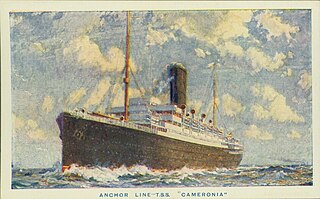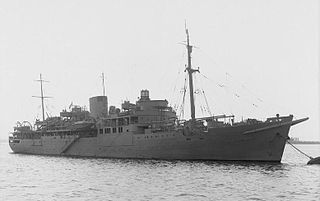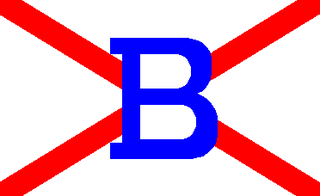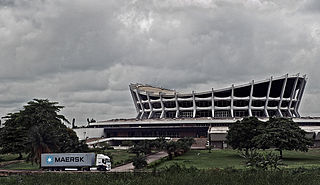
HMS Jamaica, a Crown Colony-class cruiser of the Royal Navy, was named after the island of Jamaica, which was a Crown Colony when she was built in the late 1930s. The light cruiser spent almost her entire wartime career on Arctic convoy duties, except for a deployment south for the landings in North Africa in November 1942. She participated in the Battle of the Barents Sea in 1942 and the Battle of North Cape in 1943. Jamaica escorted several aircraft carriers in 1944 as they flew off airstrikes that attacked the German battleship Tirpitz in northern Norway. Late in the year she had an extensive refit to prepare her for service with the British Pacific Fleet, but the war ended before she reached the Pacific.

RFA Abbeydale (A109) was a fleet tanker of the Royal Fleet Auxiliary and was originally one of six ships ordered by the British Tanker Co which were purchased on the stocks by the Admiralty. She was built by Swan Hunter and Wigham Richardson Ltd and launched on 28 December 1936. Abbeydale served until being decommissioned on 18 September 1959 and laid up at HMNB Devonport. She was then sold for scrapping, arriving at the Thos W Ward breakers' yards at Barrow-in-Furness on 4 September 1960.

HMS Euryalus was a Dido-class cruiser of the Royal Navy. She was laid down at Chatham Dockyard on 21 October 1937, launched on 6 June 1939, and commissioned 30 June 1941. Euryalus was the last cruiser built at the dockyard.

ORP Piorun was an N-class destroyer operated by the Polish Navy in World War II. The word piorun is Polish for "Thunderbolt". Ordered by the Royal Navy in 1939, the ship was laid down as HMS Nerissa before being acquired by Poland, before completion, in October 1940.

HMS Argonaut was a Dido-class cruiser of the British Royal Navy which saw active service during the Second World War. Constructed at the Cammell Laird shipyard, Birkenhead, Argonaut was laid down in 1939, launched in September 1941, and formally commissioned into service on 8 August 1942.

A Landing ship, infantry (LSI) or infantry landing ship was one of a number of types of British Commonwealth vessels used to transport landing craft and troops engaged in amphibious warfare during the Second World War. LSIs were operated by the Royal Navy, British Merchant Navy, Royal Canadian Navy, Royal Indian Navy, and Royal Australian Navy. They transported British Commonwealth and other Allied troops in sea assaults and invasions throughout the war.

HMS Loch Fyne was a Loch-class frigate of the British Royal Navy, built by the Burntisland Shipbuilding Company Ltd, Burntisland, Fife, Scotland, and named after Loch Fyne in Scotland. The ship was launched in 1944, and served at the end of World War II. Recommissioned in 1951, she served in the Persian Gulf and was scrapped in 1970.

HMS Nigeria was a Crown Colony-class light cruiser of the Royal Navy completed early in World War II and served throughout that conflict. She was named for the British colony of Nigeria.

HMS Hawkins was a Hawkins-class heavy cruiser of the Royal Navy. She was built at Chatham Dockyard and launched on 1 October 1917. With the conversion of her sister, Cavendish, to become the aircraft carrier HMS Vindictive (1918), Hawkins became the name ship of her class.

The Banff-class sloop was a group of ten warships of the Royal Navy. Built as United States Coast Guard Lake-class cutters, in 1941 these ships were loaned to the Royal Navy as antisubmarine warfare escort ships. The transfers took place at the Brooklyn Navy Yard, where the British battleship Malaya was under repair after being torpedoed by U-106. The sloops were manned for transport to England by personnel from the damaged battleship. The sloops were initially used to escort SL convoys between England and Sierra Leone, and one was sunk while so employed. The nine surviving sloops were assigned to Operation Torch where two were destroyed attacking Oran in Operation Reservist. The remaining seven escorted Mediterranean convoys in support of the North African invasion and saw varied employment in the Atlantic until assigned to the Kilindini Escort Force in late 1943 and early 1944. They stayed in the Indian Ocean for the remainder of the war escorting trade convoys in the Arabian Sea, and five served in the Bay of Bengal supporting Operation Dracula and Operation Zipper in the last months of conflict with Japan. Six were returned to the United States after the conclusion of hostilities; and one, disabled by mechanical failure, was scrapped overseas.

The Cameron-class steamers was a class of British cargo steamships. They were designed for Clan Line and were also used by Scottish Shire Line and the Royal Navy.

HMS Glengyle was a 9,919 GRT cargo ship that served in the Second World War as an infantry landing ship (large) of the Royal Navy. She carried Commonwealth and other Allied troops in amphibious operations. Glengyle was able to make good speed on long ocean voyages to operational areas and then, by means of the many landing craft carried aboard, land assault infantry, vehicles, and stores on contested shores.
HMS Hilary may refer to one of the following Royal Navy ships, both of which were Booth Steamship Company passenger liners requisitioned by the Royal Navy:

HMS Tetcott was a Type II British Hunt-class destroyer built for the Royal Navy during World War II. She was the only Royal Navy ship to be named after the Tetcott fox hunt.

Cameronia was a British ocean liner which was built in 1920 by William Beardmore & Co Ltd, Port Glasgow for the Anchor Line. She was requisitioned for use as a troopship in the Second World War, surviving a torpedo attack. In 1953 she was requisitioned by the Ministry of Troop Transport (MoTT) and renamed Empire Clyde. She was scrapped in 1957.
HMS Royal Scotsman was an LSI of the British Royal Navy that served during World War II. A former passenger ferry, she saw action in the Mediterranean during the invasions of North Africa, Sicily and Italy.
During the Second World War, the Royal Navy commissioned several headquarters ships, which were responsible for communication between aircraft, ships and shore during amphibious operations. The first such recognised ship was HMS Bulolo.

HMS Bulolo was a 6,267 ton passenger and cargo ship of the Burns, Philp Shipping Company operating in the South Pacific. In 1939 she was converted into an Armed Merchant Cruiser, then a Landing Ship Headquarters (LSH) in 1942. She directed the landings in North Africa, Sicily, Anzio and Normandy during World War II.

HMS Albrighton was a Type III Hunt-class destroyer built for the British Royal Navy. She entered service in February 1942, first carrying out an attack on German ships in the English Channel then taking part in the Dieppe Raid, rescuing survivors from the sinking destroyer HMS Broke. Albrighton was next assigned to search for and destroy the German auxiliary cruiser Komet, then escorted a convoy to Gibraltar in prevision of the Allied landings in North Africa. Between December 1942 and April 1943, she participated in the sinking of three more Axis ships with the First Destroyer Flotilla. During the Normandy Landings in June 1943, Albrighton served as a headquarters ship, then sank two German trawlers in the weeks after the invasion. After being converted to a destroyer in early 1945, she was damaged in a collision with a Landing Ship, then was assigned to the British Eastern Fleet. However, the war ended before she was deployed and Albrighton went into reserve.

RMS Otranto was an ocean liner that was built for the Orient Steam Navigation Company in 1925. The "RMS" prefix stands for Royal Mail Ship, as she carried overseas mail under a contract between Orient Line and Royal Mail. Otranto was in service until 1957, when she was sold for scrap.



























